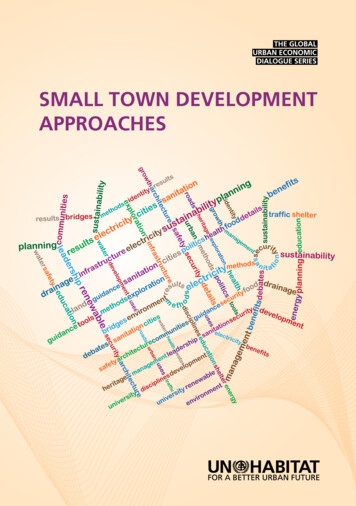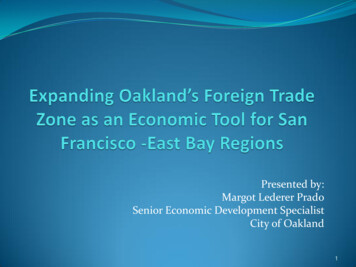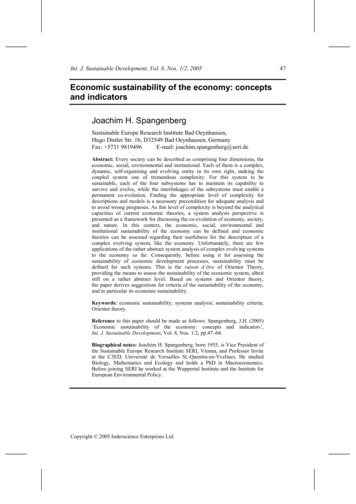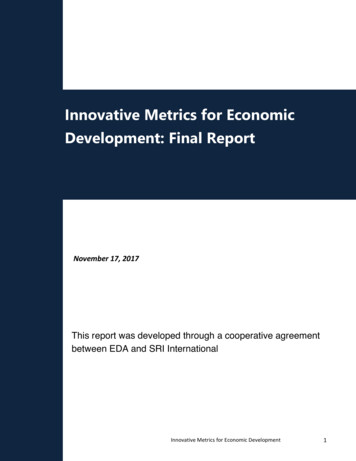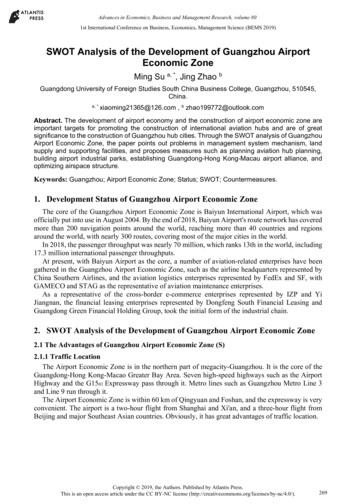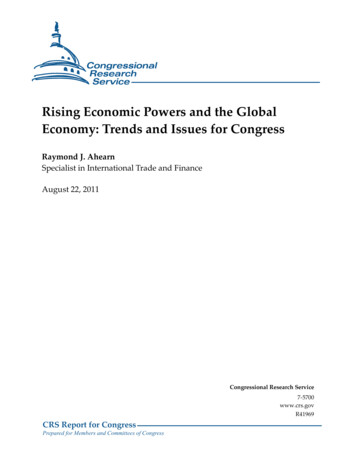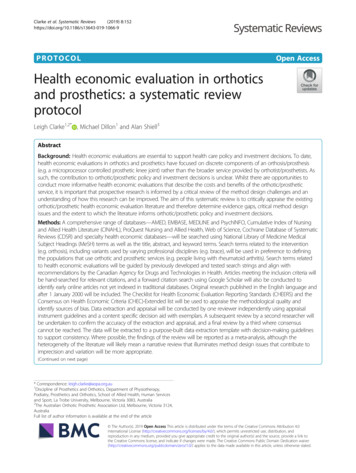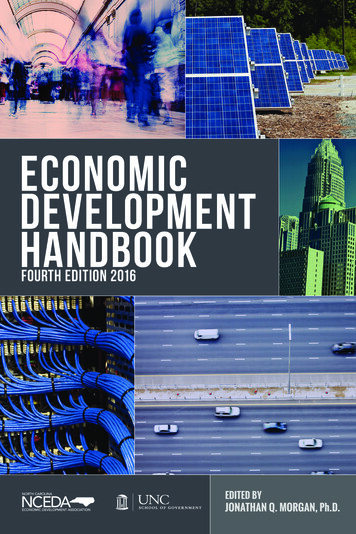
Transcription
EconomicDevelopmentHandbookfourth edition 2016
EconomicDevelopmentHandbookfourth edition 2016
The School of Government at the University of North Carolina at Chapel Hill works to improve the lives ofNorth Carolinians by engaging in practical scholarship that helps public officials and citizens understandand improve state and local government. Established in 1931 as the Institute of Government, the Schoolprovides educational, advisory, and research services for state and local governments. The School ofGovernment is also home to a nationally ranked Master of Public Administration program, the NorthCarolina Judicial College, and specialized centers focused on community and economic development,information technology, and environmental finance.As the largest university-based local government training, advisory, and research organizationin the United States, the School of Government offers up to 200 courses, webinars, and specializedconferences for more than 12,000 public officials each year. In addition, faculty members annually publishapproximately 50 books, manuals, reports, articles, bulletins, and other print and online content relatedto state and local government. The School also produces the Daily Bulletin Online each day the GeneralAssembly is in session, reporting on activities for members of the legislature and others who need tofollow the course of legislation.Operating support for the School of Government’s programs and activities comes from many sources,including state appropriations, local government membership dues, private contributions, publicationsales, course fees, and service contracts.Visit sog.unc.edu or call 919.966.5381 for more information on the School’s courses, publications,programs, and services.Michael R. Smith, D eanThomas H. Thornburg, S enior A ssociate D eanFrayda S. Bluestein, A ssociate D ean for Facult y D evelopmentBradley G. Volk, A ssociate D ean for A dministrationFacult yWhitney AfonsoTrey AllenGregory S. AllisonDavid N. AmmonsAnn M. AndersonMaureen BernerMark F. BottsPeg CarlsonLeisha DeHart-DavisShea Riggsbee DenningSara DePasqualeJames C. DrennanRichard D. DuckerJoseph S. FerrellAlyson A. GrineNorma HoustonCheryl Daniels HowellJeffrey A. HughesWillow S. JacobsonRobert P. JoyceDiane M. JuffrasDona G. LewandowskiAdam LoveladyJames M. MarkhamChristopher B. McLaughlinKara A. MillonziJill D. MooreJonathan Q. MorganRicardo S. MorseC. Tyler MulliganKimberly L. NelsonDavid W. OwensLaToya B. PowellWilliam C. RivenbarkDale J. RoenigkJohn RubinJessica SmithMeredith SmithCarl W. Stenberg IIIJohn B. StephensCharles SzypszakShannon H. TuftsVaughn Mamlin UpshawAimee N. WallJeffrey B. WeltyRichard B. Whisnant 2016 NCEDA and School of Government, The University of North Carolina at Chapel HillUse of this publication for commercial purposes or without acknowledgment of its source is prohibited. Reproducing,distributing, or otherwise making available to a non-purchaser the entire publication, or a substantial portion of it,without express permission, is prohibited.Printed in the United States of America20 19 18 17 16 1 2 3 4 5ISBN 978-1-56011-871-8This publication is printed on permanent, acid-free paper in compliance with the North Carolina General Statutes.Printed on recycled paper
oduction to Economic Development ixWhy North Carolina Is Involved 1History 1The Need for Economic Development Programs 3Helping Companies and Communities Compete 5Participants 7Local Developers 7Regional Developers 9State Developers 11Economic Development Allies 12The Role of Elected Officials 13The Process 17Strategic Visioning and Planning 17Strategies 19Retaining and Expanding Existing Firms 20Improving Local Linkages 21Creating New Firms and Promoting Entrepreneurship 22Capturing New Dollars 23Recruiting New Facilities 24Tools 25Marketing and Recruitment Tools 25Business Retention and Expansion Tools 26Entrepreneurship Tools 26The Need for Product 27How a Business Location Project Happens 30A Typical Project 30
Financial Incentives 33Current Financial Assistance Programs 35State Programs 35Regional Programs 38Local Programs 39Local Incentive Examples 39Industrial Revenue Bonds (IRBs) 40Project Development Financing 41The Future of Economic Development in North Carolina 43Endnotes 45Resources 47ivContents
PrefaceAs the fourth edition of this handbook is being written, North Carolina continues to press toward a full and robust economic recoveryafter having reinvented its economic development approach in manyrespects. One of the major changes at the state level resulted in shifting responsibility for marketing, prospect management, tourism, andinternational trade to a newly created private entity called the EconomicDevelopment Partnership of North Carolina (EDPNC). Other significantchanges in the last few years have included eliminating statutory taxcredits, adopting a new regional model, and taking a different approachto rural development.The reset of state-level economic development efforts coincides withthe work of a new Reimagining Committee of the North Carolina Economic Development Association (NCEDA), which is taking a fresh lookat NCEDA’s structure, programming, and other services provided toits members. The goal is to assure that NCEDA will be as relevant aspossible to its members and will return the highest value to them insupport of economic development in North Carolina.North Carolina’s current marketing slogan—“Nothing Compares”—seeks to differentiate the state and draw attention to its many distinctiveassets. This latest branding effort is consistent with previous campaignsthat billed North Carolina as the “State of Minds” and “A Better Placeto Be”. The point is that North Carolina has a lot working in its favor.An economic recovery marked by fits and starts can be unsettling.But even in this volatile environment, the state continues to be a topdestination for businesses and residents alike. This is due to the state’scommitted leadership and support for economic development and itsmany assets, including a skilled and talented workforce; an extensivenetwork of universities and community colleges; a high quality of life;v
attractive natural, cultural, and recreational amenities; geographiclocation; and a mild climate. These assets make North Carolina wellpositioned for a renewed prosperity as the economy gains steam.The work of economic development endures and the ultimate mission remains clear: to preserve and enhance the standard of living forNorth Carolina’s residents amid a rapidly changing economy in whichthe state must compete globally for its share of domestic and foreigninvestment.The work of keeping North Carolina competitive is implementedthrough a network of organizations and professionals who employ various policies, programs, and tools in a process that is not always wellunderstood. NCEDA partnered with the School of Government at theUniversity of North Carolina (UNC) to prepare this publication as abasic introduction to economic development. It is offered as an educational resource for legislators, policymakers, community leaders, andinterested citizens across the state who desire to keep North Carolinacompetitive in its quest for new jobs and investment.Ernie Pearson, President, NCEDAJonathan Q. Morgan, Ph.D.June 2016viPreface
AcknowledgmentsIn 2001 several NCEDA members volunteered their time to create theoriginal version of the Economic Development Handbook in order toeducate North Carolinians about the constantly changing professionof economic development. Robin Hiott Spinks chaired the committeethat developed the first edition; committee members included Ray Burrows, Doug Byrd, Brenda Daniels, Jim Fain, Oppie Jordan, Bob Leak Jr.,Dianne Reid, Steve Yost, and Lawrence Bivins. In 2003 Leslie Scott ledthe effort to revise the first edition. Committee members who workedon the second edition of this handbook include Ronnie Goswick, ScottMillar, John Peterson, and Mac Williams.The third edition of the handbook in 2009 was made possible througha partnership between NCEDA and the UNC School of Governmentunder the direction of Professor Jonathan Q. Morgan. That editionupdated and augmented much of the original content with information on new approaches, policies, programs, examples, and emergingtrends within the field. NCEDA members who offered suggestions forrevisions and reviewed drafts for the third edition included Len Kulik,Michael Smith, Joanna Helms, and Scott Hamilton. George Sherrillhelped update the information on state financial programs that areavailable.Professor Morgan led the effort to substantially update and reviseprevious content in order to produce this fourth edition of the handbook.This edition reflects the many significant changes that have occurredin North Carolina’s approach to economic development in the last fewyears. The following NCEDA members helped identify sections thatneeded updating and reviewed drafts of the new handbook: BrendaDaniels, Loren Hill, Randall Johnson, Gary Lanier, Maureen Little,Crystal Morphis, Michael Smith, and Steve Yost.vii
Introduction to Economic DevelopmentEconomic development is both a process and a set of desired outcomes.The process is multifaceted and dynamic and results in new privateinvestment, job creation, increased wealth, and a higher standard ofliving for residents. What drives economic development is private sector business activity; that is, businesses of all sizes starting up, relocating, or expanding in an area. They may be involved in manufacturing,distribution, agriculture, transportation, research and development(R&D), business services, or other sectors of the economy. The investment these businesses make in a community gives rise to a range ofrelated commercial activities and services. Residential growth can alsooccur, bringing a wide variety of retail, consumer services, recreational,tourism, and other commercial enterprises.The ripple effect of new jobs and investment can be significant. Theanalytical model used by the N.C. Department of Commerce to gaugeeconomic impact shows, for example, that every 100 new jobs in semiconductor manufacturing generate an additional 134 jobs as a result ofindirect and induced economic activity. The model estimates that every 5 million in manufacturing facility construction investment spursanother 2.6 million in statewide spending. New jobs and investment,in turn, generate income, sales, and property tax revenues for local andstate governments to spend on crucial public services and amenitiesthat help attract more firms and residents and enhance quality of life.Economic development is conducted by a network of professionalsusing an array of tools designed to encourage private investment and jobix
creation which, in turn, help grow local, regional, and state economies.It can be defined as the specific activities, programs, and tools aimed at stimulating private investment to expand a tax base; increasing employment opportunities, wages, and personalincomes; and increasing wealth in a community.Economic development can help expand and balance a tax base sothat a jurisdiction will have the resources it needs to provide highquality public services at a reasonable cost to its residents. Balancingthe tax base among the various land uses—agricultural, residential,commercial, and industrial—is especially important for the many “bedroom” communities that exist in North Carolina. These communitiesrely on local tax bases comprised mostly of residential property. Theproblem is that residential development does not typically generatesufficient tax revenues to pay for the public services it requires. Bycontrast, commercial and industrial development projects usually payfor themselves and produce net tax revenues in excess of the costs forneeded public services.Economic development efforts produce other highly desirable outcomes. One example of this is the broadening of a community’s leadership base as new companies bring in executives and entrepreneurs whocan participate in various local organizations and programs. Anotherexample is that new companies can provide a community with supportin the form of philanthropy and volunteerism.xEconomic Development Handbook
Why North Carolina Is InvolvedHistoryNorth Carolina has undergone considerable economic change since thearrival of its early settlers, when the state prospered in trading, fishing,and farming. After the industrial revolution, as new railroads and highways began crisscrossing the state, North Carolina’s economy shiftedtoward other types of economic activity. The Piedmont Triad regionbuilt an economy on manufacturing; the Triangle region emerged as acenter for government and higher education; and Charlotte establisheditself as a financial services and distribution hub.During the late 1950s a milestone in North Carolina economicdevelopment occurred, as Governor Luther Hodges and a handful ofgovernment, university, and business leaders began to plan a projectthat would eventually transform the state’s economy.1 The idea wasto attract companies to locate to assembled parcels of land locatedbetween Raleigh and Durham. By the late 1960s the resulting ResearchTriangle Park (RTP) had landed major anchor tenants that would laythe foundation for it to become a global model of a successful technology park that is affiliated with research universities. At the sametime North Carolina experienced a rapid expansion in its traditionalindustries—textiles and furniture—as U.S. manufacturing jobs movedsouth. Tobacco farming and processing were also strong industriesduring this period.North Carolina has benefited from visionary leadership, and government and private sector entities have worked well together to makethe state attractive to new businesses. Some of the state’s major publicinvestments have included: the expansion of the North Carolina Community CollegeSystem;1
customized workforce training for new, expanding, andexisting companies; support for the campuses of the University of North CarolinaSystem; and the construction of an extensive highway network.Because of these strategic state investments, businesses in North Carolina can get workers trained, access talent and innovation, and movetheir product to market. These public investments, along with a business-friendly regulatory environment, have resulted in North Carolinabeing regularly ranked among the best locations in the United Statesfor industry by Site Selection, a leading economic development tradepublication.2In recent decades the trend of declining employment in the state’straditional industries has caused significant economic disruption andtransition. This trend has made the work of economic developers inNorth Carolina more challenging but also more essential to efforts torebuild and sustain a vibrant economy in the state. Agriculture, long aleading economic engine, is suffering from a sectorwide decline that isimpacting both large and small growers. Tobacco production and cigarette manufacturing have declined substantially since the 1997 nationalMaster Settlement Agreement. Similarly, the erosion of manufacturingjobs—particularly in the textile, apparel, and furniture sectors—hasadversely affected the state’s urban and rural areas alike. (See Table1A, below.)Employment growth in the state is now primarily driven by nonmanufacturing sectors of the economy such as educational services,health care, real estate, and arts/entertainment/recreation. (See Table1B, below.) Only five manufacturing sectors experienced any notablejob growth from 2004 to 2014, while many others saw sharp declines.Overall, the total number of manufacturing jobs declined by 20.8 percent during this period due to the continuing effects of globalization,automation, and industrial restructuring. Despite the job loss, sometechnology-intensive, advanced manufacturing sectors are emergingas vital parts of the state’s economy.2Economic Development Handbook
Table 1A. North Carolina Employment Change in SelectedManufacturing Sectors between 2004 and 2014Total Number of Jobs%Sector20042014 ChangeOther transportation equipment manufacturingMiscellaneous manufacturingPrimary metal 826.851,67155,0926.6Machinery manufacturing32,06232,8012.3Plastics and rubber products manufacturing33,54832,392-3.4Chemical manufacturing46,56243,889-5.7Fabricated metal product manufacturing40,48737,797-6.6Food manufacturingNonmetallic mineral product manufacturing17,70015,140-14.5Motor vehicles, bodies and trailers, and parts manufacturing28,37923,978-15.5Paper manufacturing19,52116,016-18.0Computer and electronic product manufacturing39,75732,564-18.1Printing and related support activities16,81413,596-19.1Electrical equipment, appliance, and component manufacturing 27,22421,929-19.4Beverage and tobacco product manufacturing15,67311,327-27.7Wood product manufacturing28,36818,774-33.8Furniture and related product manufacturing61,09536,384-40.4Textile product mills manufacturing14,3946,610-54.1Textile mills manufacturing63,03228,505-54.8Apparel manufacturing27,60510,442-62.2597,455 473,437-20.8Total ManufacturingSource: U.S. Department of Commerce, Bureau of Economic Analysis, Interactive Data: RegionalData, GDP & Personal Income, http://1.usa.gov/1X96wDK.The Need for Economic Development ProgramsVirtually every state in the country has an economic development program working to recruit and retain industry, and several thousand cities,towns, and counties across the United States are vying for new businessinvestment. With an increasing number of communities participatingand making greater use of economic development strategies, NorthCarolina must constantly assess its competitive position and retool asneeded. This requires a commitment to enhancing the programs thatWhy North Carolina Is Involved3
Table 1B. North Carolina Employment Growth in SelectedNon-Manufacturing Sectors between 2004 and 2014Total Number of Jobs%Sector20042014 ChangeOil and gas extraction1,6195,084214.0Other information 746.9Educational servicesTransit and ground passenger transportationWaste management and remediation servicesArts, entertainment, and recreationReal estateSupport activities for agriculture and forestry7,63710,98043.882,583117,52842.3148,919 208,93940.312,05416,19034.3Professional, scientific, and technical services246,028 322,54631.1Finance and insurance188,783247,01130.8Management of companies and enterprises64,88483,43128.6Health care and social assistance436,269550,16126.1Accommodation and food services325,166 406,339Warehousing and storage19,98725.024,67923.5General merchandise stores87,053 e: U.S. Department of Commerce, Bureau of Economic Analysis, Interactive Data: RegionalData, GDP & Personal Income, http://1.usa.gov/1X96wDK.led to past success and a renewed effort to remain innovative in theface of new economic realities.Historically, North Carolina’s geographic location, climate, quality oflife, educational institutions, highway network, and positive businessclimate enabled the state to be competitive in economic developmentwithout necessarily providing much in the way of incentives. But asother states have become more intent on competing for jobs and investment, they have implemented aggressive programs for recruiting industry. A series of industrial project losses in the 1990s, including the lossof Mercedes-Benz to Alabama, BMW to South Carolina, and Motorolato Virginia, prompted North Carolina public officials to take a moreassertive stance with respect to economic development incentives.4Economic Development Handbook
Localities throughout the U.S. are also developing programs tobecome more attractive as business destinations. These include financial incentives, public-private partnerships to develop business parksand buildings, workforce development initiatives, and other programsfocused on the needs of business. The result is that there are many morecommunities seeking business locations than there are projects. Thenumber of large industrial recruitment projects has declined over timewhile the use of incentives to lure them has increased. In a given year itis estimated that, on average, some 15,000 communities vie for roughly1,500 major industrial development projects available nationally.3 Thismeans that North Carolina’s communities face increasingly aggressivecompetition for every major business location project.North Carolina also continues to support economic developmentas a way to raise the standard of living and quality of life for all of itsresidents, particularly those in economically distressed urban and ruralareas who are at risk of being left behind in the new economy. Thispolicy goal of promoting “widely shared prosperity” has seen renewedemphasis lately amidst a growing concern about rising inequality andthe deepening economic divide between the state’s urban and ruralareas.4Helping Companies and Communities CompeteCompanies know that they bring value to their host communities, avalue that is easily measured by the new jobs, higher wages, and additional tax revenue they produce. Many companies also want to addvalue to their own products and services. In order to expand jobs incommunities and increase the value of their enterprises, businessesmust be profitable. A relentless focus on the bottom line is critical.American companies now operate in a global economy, competingwith firms across the world. In many other countries the costs of doingbusiness are sharply lower. The result is that most U.S. firms now mustconstantly seek new ways to add value and operate more efficiently inorder to stay in business.Why North Carolina Is Involved5
North Carolina can help companies add value by providing andfacilitating: A talented and productive workforce—educated, skilledpeople who are the products of high-quality schools. Theseworkers must understand how to be productive, qualityfocused, and innovative and know how to use technology andteamwork for continuous improvement. Access to innovation—ideas, knowledge, and research anddevelopment (R&D) that generate new technologies, products,and processes that help firms establish new niches and boostproductivity. Access to markets—good roads, rail, airports, seaports,and high-speed Internet connections that move productsand services quickly and securely to a larger number ofconsumers.North Carolina can help businesses operate more productively andefficiently by ensuring that the following are available: Cost-effective worker training programs Competitive state and local tax rates Streamlined, consistent, and predictable governmentregulations Expedited permitting processes that reduce the risks and costsassociated with construction delays Adequate and affordable utility infrastructure (water, sewer,electricity, natural gas, and modern telecommunications,including broadband Internet and digital wireless networks) Access to inputs and raw materials Low construction costs for sites and buildings Financial incentives6Economic Development Handbook
ParticipantsEconomic development professionals work in a diverse array of agencies and organizations across all levels of governance and represent arange of functional interests. They may be employed by: Municipalities State agencies Counties Federal agencies Regional organizationsThey are employed by organizations of all types, including: Public Public-private Private NonprofitThese organizations, along with the professional network itself, areconstantly adjusting to meet new and changing demands. There isalso an ongoing effort to minimize duplication and overlap amongeconomic development organizations. What follows is a descriptionof the various participants and the particular roles they play in theprocess of economic development.Local DevelopersLocal economic developers may work for: County or city governments Semi-autonomous public economic development commissions Public-private entities, which may be chartered as nonprofiteconomic development corporations Chambers of commerce or other private organizations, suchas Committees of 1007
Each type of structural arrangement has its own advantages anddisadvantages given the local business environment, the level of financial resources available to fund the program, and the overall nature ofgovernance within the community. In some cases multiple countiesand municipal governments have partnered to support joint programs.Over time localities can modify how they organize and structure theireconomic development activities in order to clarify roles and responsibilities, improve services, streamline programs, and create cost savings.For example, in 2015 the Greensboro and High Point economic development groups—along with their respective municipal governments andGuilford County—formed a close working alliance in order to presenta more cohesive presence to clients. In 2013 the City of Monroe andUnion County merged their respective economic development groupsto form Monroe–Union County Economic Development. This decisionunified economic development efforts within the county for the firsttime in twenty years.In 2006 Wayne County replaced its economic development commission, which had been in existence since 1966, with a new, nonprofit,public-private organization tasked to perform economic developmentcountywide. The resulting entity, the Wayne County Development Alliance, Inc., is a formal partnership between the Wayne County Board ofCommissioners, the Goldsboro Committee of 100, and the Mount OliveCommittee of 100. Another example is the Carolinas Gateway Partnership, which was created in 1995 to merge the economic developmentactivities of two counties, Edgecombe and Nash, into one nonprofitorganization.Local developers take the lead in the production of promotional andinformational materials, making sure that the latest data about thecommunity are available and easy to obtain. Often in the form of webbased community profiles, this information will typically highlightexisting business and industry and include data on the local workforce,schools, wage/income levels, demographics, industry composition, taxes,housing, and quality of life. Local developers strive to keep local business leaders informed about their programs. It is also the developers’responsibility to ensure that available sites and buildings are listed inlocal, regional, and state databases.8Economic Development Handbook
Local development professionals stay current on all relevant statelaws, regulations, and local ordinances. That means keeping in touchwith city council members, county commissioners, state legislators,and other elected officials whose help will be needed at some point.Local developers interface closely with allies, as described later, onissues such as product development, infrastructure, workforce readiness, and project financing.Local developers are a primary source of information and supportfor existing businesses seeking to expand their operations as well asprospective businesses seeking to locate in the area. The local developeris often the main point of contact for a client in determining what typesof assistance are available with respect to grants, incentives, workertraining, and permitting. The local developer must have an in-depthknowledge of what programs are available, who to call for help andsupport, and where to access information needed to address clientneeds and concerns.Local development professionals are at the center of the economicdevelopment process and facilitate new business locations, existingbusiness expansions, and support for new business starts. They provideproject leadership and ensure that stakeholders at all levels work as ateam. Their facilitative role is particularly important in the currentenvironment, as the timeline for industrial projects has decreased fromeighteen to twenty-four months to as little as four to six months.Regional DevelopersIn 2014 North Carolina revamped its regional approach and designatedeight new geographic regions to serve as “prosperity zones” for economic development purposes. (See Figure 1, below.) The newly createdEconomic Development Partnership of North Carolina (EDPNC) hasregionally-based economic developers who focus their efforts on oneof the eight zones.The other major regional players are the regional economic development partnership organizations. At present, four regional partnershipParticipants9
Figure 1.Prosperity Zones ls(South Central)RegionNortheastRegionSoutheastRegiongroups exist to coordinate national and international marketing activities on behalf of the multi-county regions they serve: Charlotte Regional Partnership, based in Charlotte, supportstwelve surrounding North Carolina counties and fourcounties in South Carolina. (See www.charlotteusa.com.) NC East Alliance, based in Greenville, supports twenty-foursurrounding counties. (See www.nceast.org.) North Carolina’s Southeast, based in Elizabethtown, supportssixteen surrounding counties. (See www.ncse.org.) Research Triangle Regional Partnership, based inCary, supports sixteen surrounding counties. (Seewww.researchtriangle.org.)The regional economic development partnership organizations market the unique assets of their respective regions and work closely withstate and local developers to address regional economic issues; generateleads; manage prospect inquiries; promote product development; provide research assistance; and publicize improvements in transportation,infrastructure, and the labor force. These entities no longer receive anystate approp
approximately 50 books, manuals, reports, articles, bulletins, and other print and online content related . and personal incomes; and increasing wealth in a community. Economic development can help expand and balance a tax base so . Economic development efforts produce other h

